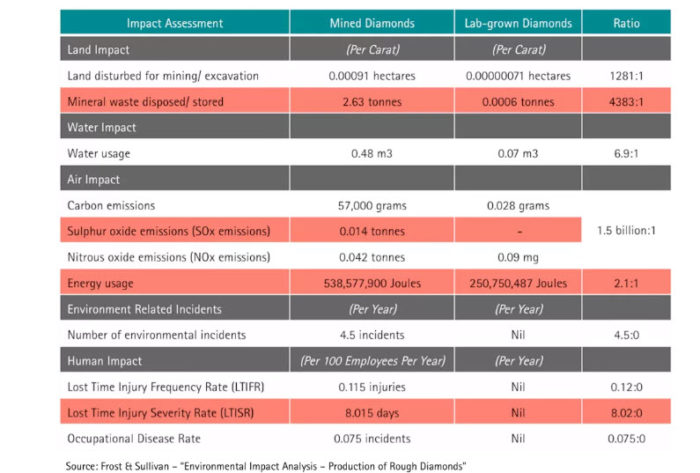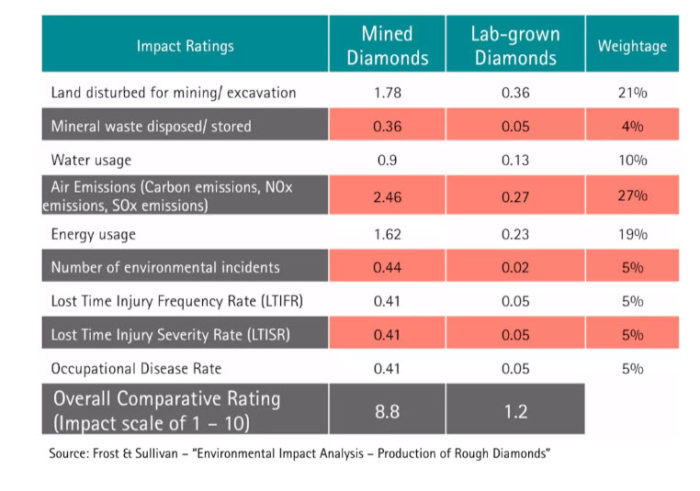Sustainability is one of the main arguments supported by synthetic diamonds manufacturers to promote their product as an alternative to mined diamond. Sustainability is perceived in terms of carbon footprints, ecology and social/human impact. First, producing diamonds aboveground requires a considerably less amount of energy and synthetics can even be carbon neutral if renewable energy is applied. Secondly, mining can devastate the natural beauty and local ecology of the area where the mines are located while laboratories use a small amount of land to construct their facilities and require no earth displacement. Finally, mining often implies the removal of local populations and loss of habitats for their daily life, as well as health hazard and accidents. On the other hand, a lab-grown diamond facility does not have any of these implications, as it operates just like any other laboratory (Frost & Sullivan, 2014; IIa Technologies).
Are all these arguments empirically grounded? While a significant part of the literature has focused on the environmental and social impact of mined diamonds, similar data are still lacking for synthetic diamonds. Anyway, the research conducted so far seems to confirm the arguments presented above.
Frost & Sullivan, a global research and consulting firm, carried out an extensive environmental impact assessment for both mined diamonds and lab-grown diamonds and published a comparative analysis between the environmental and social impact of natural versus synthetic diamonds. Various environmental parameters have been considered for the study, including carbon emissions, water usage, energy usage, waste generated, land disturbed etc. (Shah, 2014).
This relative comparison clearly shows the environmentally detrimental impact mined diamond causes compared to lab-grown diamonds. To benchmark the overall impact caused by both mined diamonds and lab-grown, the study assigned weights to various parameters and found the rating results (Shah, 2014).
These numbers clearly show that mined diamonds’ overall impact is more than 7 times than that of lab-grown diamonds.
Similar findings have been collected from other analysis. These have been mainly conducted and published by individual synthetic companies to make their diamonds appealing for ethical consumers. An example is the IIa technologies company, based in Singapore, which has compared its carbon footprint to the one of Ekati mines in Canada and its ecological impact to the ones of Ekati, Mirny and Kimberley Mines (IIa Technologies).
Note: The values for Carats per tonne of earth displaced and grams per tonne of earth displaced are an average taken for Ekati, Mirny and Kimberley Mines
Source: IIa Technologies
Another comparative analysis has been carried out between the US lab-grown company Gemesis and the Canadian Ekati mine. The data suggest that replacing one mine’s annual diamond production with synthetic diamonds created in a laboratory, could save the equivalent of about 483 million miles’ worth of auto emissions (Martin, 2011).
All these findings suggest that synthetic diamonds are a concrete sustainable alternative for consumers. Anyway, these results cannot be generalised. As one of the biggest synthetic company, Diamond Foundry, suggests, the environmental footprint of lab-grown diamonds could be larger if they are produced with inefficient technology and coal-fired power (Diamond Foundry).
In conclusion, we can certainly state that synthetic diamonds are potentially more sustainable than natural diamonds but the real impact should be analysed case by case. Further research is needed to have a more precise picture of the issue.
Written by Costanza Ghera
SOURCES
Diamond Foundry. What is the environmental impact of mined vs aboveground diamonds? Retrieved from https://diamondfoundry.com/blogs/the-foundry-journal/whats-the-environmental-impact-of-mined-vs-aboveground-diamonds
IIa Technologies. IIa Technologies and Sustainability. Retrieved from http://2atechnologies.com/iia-technologies-and-sustainability/
Shah, V. (2014, December 20). Lab-Grown Diamonds Represent Long-term Environmental Solution: Frost & Sullivan. Better Diamond Initiative. Retrieved from https://betterdiamondinitiative.org/lab-grown-diamonds-represent-long-term-environmental-solution-frost-sullivan/
Frost & Sullivan. (2014, December 16). Grown Diamonds Offer an Eco-friendly Diamond Alternate, Finds Frost & Sullivan. Retrieved from https://ww2.frost.com/news/press-releases/grown-diamonds-offer-eco-friendly-diamond-alternate-finds-frost-sullivan/
Martin, A. (2011, August 31). A Man-Made Diamond Is Forever, Too: Nitty-gritty. Stanford Magazine. Retrieved from https://stanfordmag.org/contents/a-man-made-diamond-is-forever-too-nitty-gritty
featured image source: https://www.puregrowndiamonds.com/



